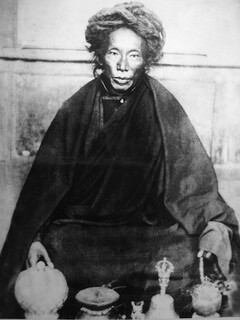Clarification and Transcendental Resolution
Brief Explanation of Clarification and Transcendental Resolution from the Oral Tradition of Nyala Sogyal
by Yukhok Chatralwa Chöying Rangdrol
Here, in the context of the Great Perfection, the natural state of the ground of obscuration is called 'awareness' (rig pa), while the stains that obscure it are referred to as 'ordinary mind' (sems).
Simply with regard to how they appear, there is a great difference between mind, which is deluded, and awareness, which is undeluded. Thus, having distinguished between mind and awareness, to be directly introduced to the face of awareness itself is what we call 'clarification' (shan 'byed).
In its manner of being, there is not the slightest iota of deluded mind that exists separately from undeluded awareness itself. There is therefore no need for any rejection or cultivation, division or exclusion at all with regard to any appearance or mental perception, whether in the realm of saṃsāra or nirvāṇa. To decide on this single, all-encompassing sphere of empty awareness is what we call 'transcendental resolution' (la bzla ba).
It is through clarification that we recognize the fresh, unaltered ground of liberation. It is through transcendental resolution that we recognize that the liberated—all rising thoughts, good or bad—have never been apart from the awareness that is the ground of liberation, and whatever arises is freed naturally by itself, just like waves on water. This is what we call 'direct revelation of self-liberation'.
In their mode of being, thoughts never pass beyond the single, all-encompassing sphere of awareness, and that awareness is itself great primordial liberation, which has never experienced delusion. Therefore, since nothing is separate from this state of liberation that is awareness, there cannot possibly be anything that is not liberated. That is to say, there are no modes of liberation and no liberation itself.
In terms of appearance, liberation refers to the fact that thoughts occur contingently, as the deluded mind and its objects arise through a failure to recognise awareness, and these are to be liberated. In this regard, at first, whatever thoughts arise seem completely separate from awareness, bringing alarm and the thought that we have fallen into delusion. Yet, as soon as we recognize them with genuine presence, like meeting an old, familiar friend, we know them as how awareness itself manifests, and they are liberated. At the intermediate stage, when we do not cling so strongly to the idea that all rising thoughts are separate from awareness, we do not rely so much on recognition. As in the example of a snake uncoiling its own knots, thoughts are purified in the essence of the genuine nature, as the natural self-liberation of whatever naturally arises. Finally, there is no longer any separation between awareness and thoughts. All that arises is completely empty within the essence of the genuine nature. With the crucial point of appearances not being ‘out there’ and awareness not being ‘only here’, all kinds of perceptions—objects both good and bad—can arise, and all kinds of thoughts, good and bad, can arise in the mind without harming awareness at all, whereas if no such perceptions occur and no such thoughts arise, this does not serve to improve awareness at all. It is like the example of a thief entering an empty house, a situation that cannot possibly bring the benefit of gain or the harm of loss. Just so, whenever thoughts do not arise this does not bring the benefit of increased freedom of awareness; and whenever thoughts do arise this does not cause the harm of slipping into delusion. Liberation and the thoughts that are to be liberated are indivisible. These are the three modes of liberation.
As we train and familiarize ourselves repeatedly with this practice of self-liberation within awareness, progressing from the path of accumulation to the end of the path, the two kinds of obscuration are gradually freed and our experience of liberation increases. Finally, with vajra-like wisdom, we are freed entirely from the obscuration of the transference of the three appearances, so that no trace remains. This is when we actualize the ultimate liberation, the precious state of perfect enlightenment.
In response to a request from someone who has gained an excellent level of realization through the practice of the secret path of Dzogpachenpo, this was written by Lerab Lingpa, who bears only the signs of upholding the vidyā-mantra tradition of Padma, Lord of the Victorious Ones.
| Translated by Adam Pearcey, 2011. Revised and first published on Lotsawa House, 2019.
Bibliography
Tibetan Edition
Chos dbyings rang grol. "Shan 'byed dang la blza'i don mdo tsam bshad pa nyag bla'i zhal rgyun" in g.Yu khog bla ma chos dbyings rang grol gyi gsung ’bum. 3 vols. Chengdu: Si khron mi rigs dpe skrun khang, 2007. Vol. 2: 428–430
Secondary Sources
Pearcey, Adam. Beyond the Ordinary Mind: Dzogchen, Rimé, and the Path of Perfect Wisdom. Boulder: Snow Lion Publications. 2018
Wallace, B. Alan. Open Mind: View and Meditation in the Lineage of Lerab Lingpa. Somerville: Wisdom Publications. 2017.
Version: 1.1-20210709
